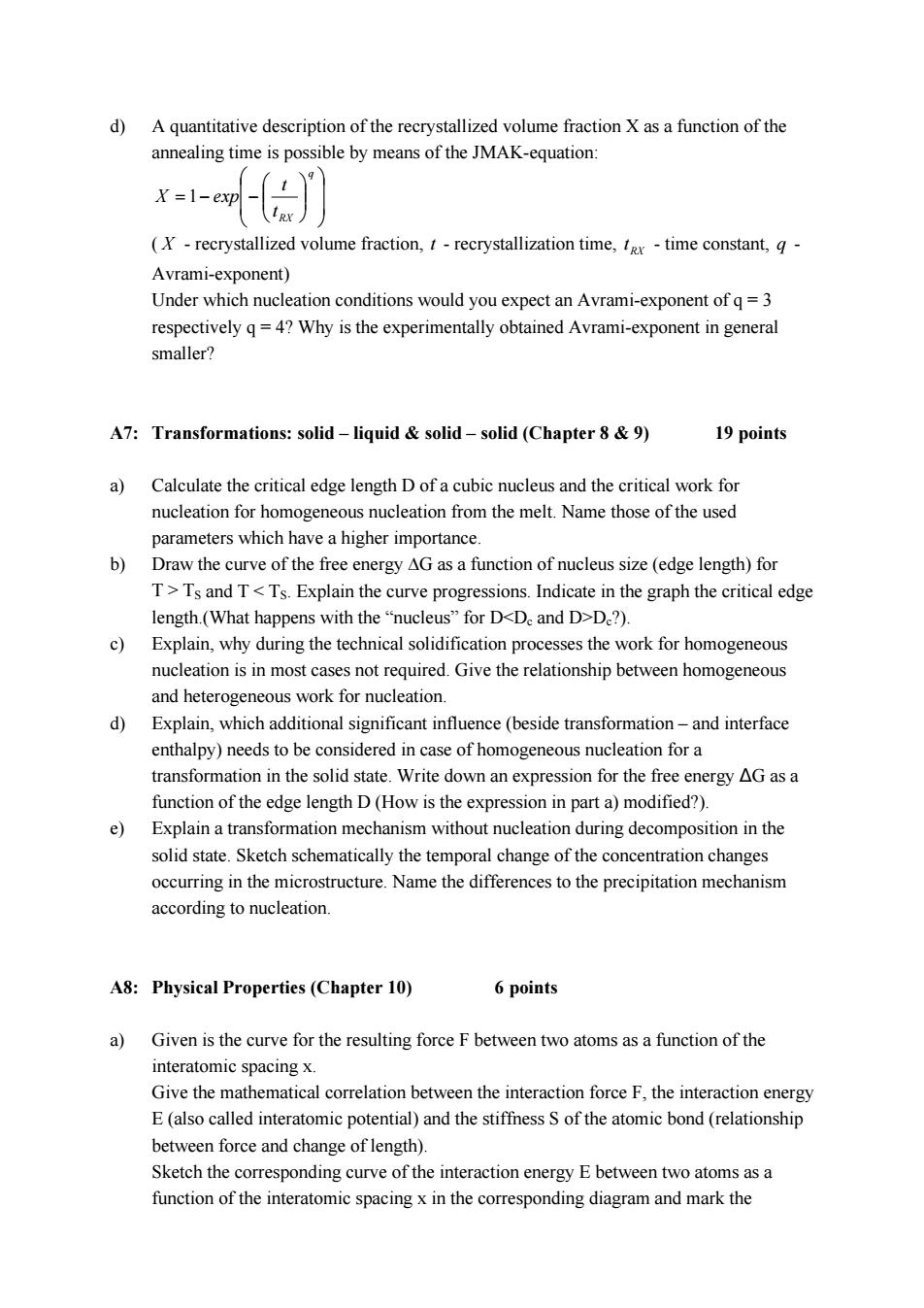正在加载图片...

d)A quantitative description of the recrystallized volume fraction X as a function of the annealing time is possible by means of the JMAK-equation: X=1-exp (X-recrystallized volume fraction,t-recrystallization time,tex -time constant,g- Avrami-exponent) Under which nucleation conditions would you expect an Avrami-exponent of q =3 respectively q=4?Why is the experimentally obtained Avrami-exponent in general smaller? A7:Transformations:solid-liquid solid-solid(Chapter 8 &9) 19 points a)Calculate the critical edge length D of a cubic nucleus and the critical work for nucleation for homogeneous nucleation from the melt.Name those of the used parameters which have a higher importance. b) Draw the curve of the free energy AG as a function of nucleus size(edge length)for T>Ts and T<Ts.Explain the curve progressions.Indicate in the graph the critical edge length.(What happens with the"nucleus"for D<D and D>De?). c)Explain,why during the technical solidification processes the work for homogeneous nucleation is in most cases not required.Give the relationship between homogeneous and heterogeneous work for nucleation. d)Explain,which additional significant influence(beside transformation-and interface enthalpy)needs to be considered in case of homogeneous nucleation for a transformation in the solid state.Write down an expression for the free energy AG as a function of the edge length D(How is the expression in part a)modified?). e) Explain a transformation mechanism without nucleation during decomposition in the solid state.Sketch schematically the temporal change of the concentration changes occurring in the microstructure.Name the differences to the precipitation mechanism according to nucleation. A8:Physical Properties(Chapter 10) 6 points a)Given is the curve for the resulting force F between two atoms as a function of the interatomic spacing x. Give the mathematical correlation between the interaction force F,the interaction energy E(also called interatomic potential)and the stiffness S of the atomic bond (relationship between force and change of length). Sketch the corresponding curve of the interaction energy E between two atoms as a function of the interatomic spacing x in the corresponding diagram and mark thed) A quantitative description of the recrystallized volume fraction X as a function of the annealing time is possible by means of the JMAK-equation: ⎟ ⎟ ⎠ ⎞ ⎜ ⎜ ⎝ ⎛ ⎟ ⎟ ⎠ ⎞ ⎜ ⎜ ⎝ ⎛ = − − q RX t t X 1 exp ( X - recrystallized volume fraction, t - recrystallization time, RX t - time constant, q - Avrami-exponent) Under which nucleation conditions would you expect an Avrami-exponent of q = 3 respectively q = 4? Why is the experimentally obtained Avrami-exponent in general smaller? A7: Transformations: solid – liquid & solid – solid (Chapter 8 & 9) 19 points a) Calculate the critical edge length D of a cubic nucleus and the critical work for nucleation for homogeneous nucleation from the melt. Name those of the used parameters which have a higher importance. b) Draw the curve of the free energy ∆G as a function of nucleus size (edge length) for T > TS and T < TS. Explain the curve progressions. Indicate in the graph the critical edge length.(What happens with the “nucleus” for D<Dc and D>Dc?). c) Explain, why during the technical solidification processes the work for homogeneous nucleation is in most cases not required. Give the relationship between homogeneous and heterogeneous work for nucleation. d) Explain, which additional significant influence (beside transformation – and interface enthalpy) needs to be considered in case of homogeneous nucleation for a transformation in the solid state. Write down an expression for the free energy ∆G as a function of the edge length D (How is the expression in part a) modified?). e) Explain a transformation mechanism without nucleation during decomposition in the solid state. Sketch schematically the temporal change of the concentration changes occurring in the microstructure. Name the differences to the precipitation mechanism according to nucleation. A8: Physical Properties (Chapter 10) 6 points a) Given is the curve for the resulting force F between two atoms as a function of the interatomic spacing x. Give the mathematical correlation between the interaction force F, the interaction energy E (also called interatomic potential) and the stiffness S of the atomic bond (relationship between force and change of length). Sketch the corresponding curve of the interaction energy E between two atoms as a function of the interatomic spacing x in the corresponding diagram and mark the